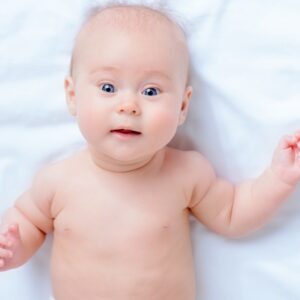Are your baby’s eyebrows twitching? Or maybe your toddler has other types of facial twitches?
In this article, we go through different causes of facial twitches and tics in children.
Mom’s Question:
Eyebrows twitching in babies – is that dangerous? My baby just completed her 1st year and a few days ago I noticed some unusual activities; it is like her eyebrows are twitching; she shakes her eyebrows up and down for 2 to 3 seconds and she does it around 20 minutes.
Are these seizure symptoms? Please advise me, I am very worried about these facial twitches (or what they are…). During her first year, she did none of this.
Thank you,
Harendra Kumar
Eyebrow Twitching, Facial Twitches, and Tics in Children
What Tics and Twitches Are and How to Tell Them Apart
First, we have to define and differentiate a twitch from a tic.
A twitch is an involuntary movement of a group of muscles that may or may not occur in repetition. The operative word here is involuntary movement, which means that it cannot be suppressed. Twitches are common symptoms of a seizure disorder.
On the other hand, a tic is a repetitive, sudden movement of muscles or vocal outbursts. They can sometimes be controlled or suppressed. Some severe forms of tics need medical management. Tics are often associated with a neurological disorder known as Tourette’s syndrome.
Possible Causes of Twitches and Tics
There are a lot of factors that can cause facial twitches or tics in children. Diagnosing such symptoms needs an in-depth investigation into a lot of things like prenatal, natal, and antenatal health of both the mother and the child. Infections, anatomic abnormalities, metabolic disorders, and genetic disorders can all cause a twitch or tic.
In general, twitches and ticks are more common in children than in adults and most are not dangerous, because the children simply outgrow these problems. It might be a good idea to think of any recent changes in your child’s daily routine. Did her sleep pattern change? Fatigue may cause muscle twitching in children. So can dehydration, which may originate from a change in the feeding pattern.
The age of the child can also narrow down the possible causes of these twitches and tics. Below is a list of possible causes of twitches or tics in children:
Facial Tic Disorder
Facial Tic Disorder – this is usually transient and can manifest as any involuntary movement in the facial muscles that occurs in succession. Cases are mostly mild and children usually outgrow them. This usually occurs at around 3 years of age. Hence at 1-year-old, your daughter is probably a bit too young for this being the reason for her eyebrow twitching.
Tourette’s Syndrome
Tourette’s Syndrome is a neurological disorder that causes involuntary facial, body movements, and vocal outbursts. Some cases may be observed in younger children; however, this is often diagnosed by the age of 5 years old.
Titches and tics caused by infection
A brain infection, including meningitis and encephalitis, in children, can cause seizures, which can be manifested by twitches or facial tics. This can occur to newborn babies (0-1 month), infants (1 month -1-year-old), and toddlers (1 year up).
It is imperative to note the occurrence of fever, neck rigidity (does she cry when she tries to move her head), altered consciousness (is she unusually sleepy or difficult to wake?), and seizures. Infections are often diagnosed through bloodwork or lumbar tap.
Brain mass
Any space-occupying brain lesion or mass can cause twitches or tics in the face, depending on the site of this mass. An electroencephalogram is usually conducted to see any abnormalities in the brain signals or brainwaves that cause seizures or twitches. This can also be diagnoses via an MRI or brain CT-scan.
This can occur in infants and children; however, these are rare.
Metabolic causes
This usually happens in newborns and infants when their magnesium, sodium, and calcium are low. This is usually due to the poor dietary intake of the mother during pregnancy. Signs and symptoms include seizures, altered consciousness, and sometimes, loss of muscle tone.
This could be a reason for your baby’s eyebrow twitching.
Seizure disorders
This is a broad category but the common theme for all seizure disorders is that there is an aura, which comes before any seizure episode. The patient is usually tired or drowsy after seizures.
There are different types of seizure disorders. One of the most common in babies is the Absence seizure. It can cause rapid blinking of the eyes and minimal facial twitching. You will know it is a seizure episode if the patient’s activity stops completely, his breathing changes, his body stiffens, they seem confused or dazed for a few seconds, they are unresponsive, and there are other jerking movements.
Another common type is the simple focal seizure. The symptoms of this type depend on the affected site in the brain.
What to Do When Your Baby has Facial Twitches
It is best to call your child’s pediatrician if you notice an unusual twitching or tics that happen in succession. You can check if your child is having a seizure by looking at his respiration, level of activity and consciousness, other signs and symptoms that may be associated with an episode of that abnormal twitching. Any sign of seizure is a red flag.
Additionally, it is also important to read up on the normal developmental milestones so that you can have a grasp on what to expect as to what your child should do by the time he reaches a certain age. Sometimes, children can be so advanced for their age. Other times, they discover things on their own and do it all over again if they had fun doing it. Take for example a baby twitching his face voluntarily. As previously mentioned, check for red flags if you are concerned about this new activity. If nothing checks out, then maybe she just likes twitching her face.
You may want to film the behavior to show it to your pediatrician, as well as document the time and situation it is appearing in.
Hope this helps,
Paula
More On Seizures And Shaking In Babies
- 4 Months Baby Shaking
- Baby’s Arm Shaking – Serious Or Not?
- Baby is Rolling Eyes! 15 Important Reasons and When to Worry
Research References: Baby’s Eyebrows Twitching
- Seizures and Epilepsy in Children
- Epilepsy in Babies
- Tic Disorders and Twitches
- Absence Seizures (Petit Mal Seizures)
- Provisional Tic Disorder: What to tell parents when their child first starts ticcing
- Tic Disorders and Tourette Syndrome in Children and Adolescents
Find comments below.

Paula Dennholt founded Easy Baby Life in 2006 and has been a passionate parenting and pregnancy writer since then. Her parenting approach and writing are based on studies in cognitive-behavioral models and therapy for children and her experience as a mother and stepmother. Life as a parent has convinced her of how crucial it is to put relationships before rules. She strongly believes in positive parenting and a science-based approach.
Paula cooperates with a team of pediatricians who assist in reviewing and writing articles.






I have always done this, but I used to twitch my nose too, I still do and I am 33 :O
My son does it too, he has an awful lot of ticks and it seems to be when he gets nervous, more so when he is scared :(
Your little lady may grow out of it or go on to ‘twitch’ something else for a while.
Hopefully, it really is nothing more serious! :)
Best wishes
CamCam